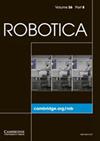A multi-stage localization framework for accurate and precise docking of autonomous mobile robots (AMRs)
IF 2.7
4区 计算机科学
Q3 ROBOTICS
引用次数: 0
Abstract
Autonomous navigation has been a long-standing research topic, and researchers have worked on many challenging problems in indoor and outdoor environments. One application area of navigation solutions is material handling in industrial environments. With Industry 4.0, the simple problem in traditional factories has evolved into the use of autonomous mobile robots within flexible production islands in a self-decision-making structure. Two main stages of such a navigation system are safe transportation of the vehicle from one point to another and reaching destinations at industrial standards. The main concern in the former is roughly determining the vehicle’s pose to follow the route, while the latter aims to reach the target with high accuracy and precision. Often, it may not be possible or require extra effort to satisfy requirements with a single localization method. Therefore, a multi-stage localization approach is proposed in this study. Particle filter-based large-scale localization approaches are utilized during the vehicle’s movement from one point to another, while scan-matching-based methods are used in the docking stage. The localization system enables the appropriate approach based on the vehicle’s status and task through a decision-making mechanism. The decision-making mechanism uses a similarity metric obtained through the correntropy criterion to decide when and how to switch from large-scale localization to precise localization. The feasibility and performance of the developed method are corroborated through field tests. These evaluations demonstrate that the proposed method accomplishes tasks with sub-centimeter and sub-degree accuracy and precision without affecting the operation of the navigation algorithms in real time.用于自主移动机器人(AMR)精确对接的多级定位框架
自主导航是一个由来已久的研究课题,研究人员已经在室内和室外环境中解决了许多具有挑战性的问题。导航解决方案的一个应用领域是工业环境中的材料处理。随着工业 4.0 的发展,传统工厂中的简单问题已演变为在自主决策结构的柔性生产岛中使用自主移动机器人。这种导航系统的两个主要阶段是将车辆从一个点安全运送到另一个点,以及按照工业标准到达目的地。前者的主要关注点是大致确定车辆的姿态以遵循路线,而后者的目标则是高精度、高准确度地到达目标。通常情况下,单一的定位方法可能无法满足要求,或者需要付出额外的努力。因此,本研究提出了一种多阶段定位方法。在飞行器从一个点移动到另一个点的过程中使用基于粒子滤波器的大规模定位方法,而在对接阶段则使用基于扫描匹配的方法。定位系统通过决策机制,根据车辆的状态和任务选择适当的方法。决策机制使用通过熵准则获得的相似度量来决定何时以及如何从大规模定位切换到精确定位。实地测试证实了所开发方法的可行性和性能。这些评估结果表明,所提出的方法可以在不影响导航算法实时运行的情况下,以亚厘米和亚度的精度和准确度完成任务。
本文章由计算机程序翻译,如有差异,请以英文原文为准。
求助全文
约1分钟内获得全文
求助全文
来源期刊

Robotica
工程技术-机器人学
CiteScore
4.50
自引率
22.20%
发文量
181
审稿时长
9.9 months
期刊介绍:
Robotica is a forum for the multidisciplinary subject of robotics and encourages developments, applications and research in this important field of automation and robotics with regard to industry, health, education and economic and social aspects of relevance. Coverage includes activities in hostile environments, applications in the service and manufacturing industries, biological robotics, dynamics and kinematics involved in robot design and uses, on-line robots, robot task planning, rehabilitation robotics, sensory perception, software in the widest sense, particularly in respect of programming languages and links with CAD/CAM systems, telerobotics and various other areas. In addition, interest is focused on various Artificial Intelligence topics of theoretical and practical interest.
 求助内容:
求助内容: 应助结果提醒方式:
应助结果提醒方式:


